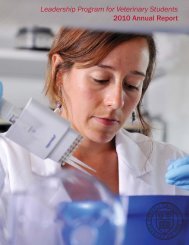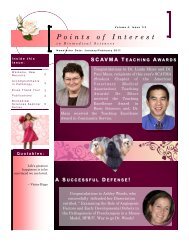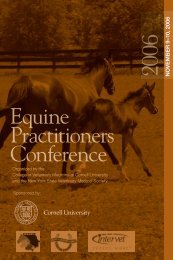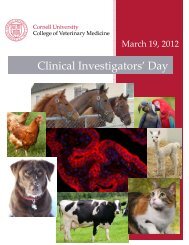From Classrooms to Clinics: - The College of Veterinary Medicine at ...
From Classrooms to Clinics: - The College of Veterinary Medicine at ...
From Classrooms to Clinics: - The College of Veterinary Medicine at ...
Create successful ePaper yourself
Turn your PDF publications into a flip-book with our unique Google optimized e-Paper software.
Committed veterinarian, enthusiastic<br />
sleuth: Lopez is all about public health<br />
Th ey are silent … even more<br />
so than a mouse. Th ey don’t<br />
smell, and <strong>to</strong> see most <strong>of</strong><br />
them takes special equipment.<br />
One <strong>of</strong> the best ways <strong>to</strong> track<br />
foo foodborne p<strong>at</strong>hogens is <strong>to</strong> ch<strong>at</strong><br />
with people who are sick: maybe, says<br />
Karen Lopez, you’ll discover they bought a pound <strong>of</strong><br />
ground beef from the same supermarket. Lopez, who will<br />
gradu<strong>at</strong>e with her Doc<strong>to</strong>r <strong>of</strong> <strong>Veterinary</strong> <strong>Medicine</strong> degree<br />
from Cornell University in 2011, thoroughly enjoyed the<br />
opportunity <strong>to</strong> become a detective while working <strong>to</strong>ward<br />
her Master <strong>of</strong> Public Health (MPH) from the University <strong>of</strong><br />
Minnesota, which she will earn in May.<br />
“Tracing foodborne outbreaks back <strong>to</strong> the very fi rst<br />
illness—possibly <strong>to</strong> the very fi rst jar <strong>of</strong> peanut butter—is<br />
fun,” said Lopez, who noted several foods th<strong>at</strong> are known<br />
culprits, including raw oysters, red raspberries, raw milk,<br />
uncooked me<strong>at</strong>s, and sprouts. “Th is is defi nitely part <strong>of</strong><br />
public health. But so is making sure <strong>to</strong> speak with pet<br />
owners about MRSA (Methicillin-resistant Staphylococcus<br />
aureus) and deworming. Th e link between veterinarians<br />
and public health is strong.”<br />
Lopez will be the fi rst gradu<strong>at</strong>e <strong>of</strong> the Cornell University<br />
<strong>College</strong> <strong>of</strong> <strong>Veterinary</strong> <strong>Medicine</strong> <strong>to</strong> also gradu<strong>at</strong>e from the<br />
University <strong>of</strong> Minnesota’s public health program, taking<br />
advantage <strong>of</strong> a partnership between the two institutions.<br />
As one <strong>of</strong> three veterinary colleges <strong>to</strong> have a formal<br />
agreement with Minnesota’s School <strong>of</strong> Public Health,<br />
Cornell students have access <strong>to</strong> a faculty advisor, online<br />
courses <strong>at</strong> Minnesota, and a pre-determined list <strong>of</strong> Cornell<br />
classes th<strong>at</strong> are accepted as transfer credits for the MPH.<br />
Th e agreement, which enables students <strong>to</strong> work <strong>to</strong>ward<br />
both degrees simultaneously, was one <strong>of</strong> the fe<strong>at</strong>ures th<strong>at</strong><br />
<strong>at</strong>tracted Lopez <strong>to</strong> Cornell.<br />
“I’ve always known I wanted <strong>to</strong> be a veterinarian,” said<br />
Lopez. “I became interested in public health while an<br />
TEACHING ...<br />
undergradu<strong>at</strong>e <strong>at</strong> Johns Hopkins where I <strong>to</strong>ok a course<br />
th<strong>at</strong> highlighted the clear connection between veterinary<br />
medicine and public health. It’s unmistakable.”<br />
Although students can apply <strong>to</strong> Minnesota’s public health<br />
program anytime during their four years as a veterinary<br />
student (and take up <strong>to</strong> seven years <strong>to</strong> complete the<br />
program), Lopez applied <strong>to</strong> both schools simultaneously,<br />
which allowed her <strong>to</strong> begin completing Minnesota course<br />
work the summer before entering Cornell. She also visited<br />
Minnesota two other summers <strong>to</strong> particip<strong>at</strong>e in the 3-week<br />
Public Health Institute, where, she says, she was able <strong>to</strong><br />
immerse herself in both the technical content and diversity<br />
<strong>of</strong> the fi eld.<br />
“At the Institutes, I collabor<strong>at</strong>ed with people from all<br />
medical fi elds, levels <strong>of</strong> training, backgrounds, and<br />
experiences,” said Lopez. “Th is diversity <strong>of</strong> people,<br />
knowledge, and outlooks on life gave me the <strong>to</strong>ols I need <strong>to</strong><br />
develop my own perspectives, perspectives th<strong>at</strong> are based<br />
on true insights in<strong>to</strong> how a particular issue aff ected people<br />
who bring many diff erent positions <strong>to</strong> the table. It is really<br />
eye-opening.”<br />
Lopez will earn her MPH this spring, aft er having<br />
completed 42 credits, a fi eld experience, and a master’s<br />
project.<br />
“Veterinarians with experience in public health have a vast<br />
array <strong>of</strong> career options,” said Kevin Cummings DVM ’96,<br />
who is currently completing his PhD in epidemiology and<br />
who serves as faculty advisor for students seeking the MPH<br />
from Minnesota. “At a time <strong>of</strong> increasing concern over<br />
emerging infectious diseases, food safety, and the health<br />
<strong>of</strong> our environment, we as a pr<strong>of</strong>ession are in demand and<br />
well-positioned <strong>to</strong> pr<strong>of</strong>oundly impact the health <strong>of</strong> our<br />
society.”<br />
www.vet.cornell.edu 11








